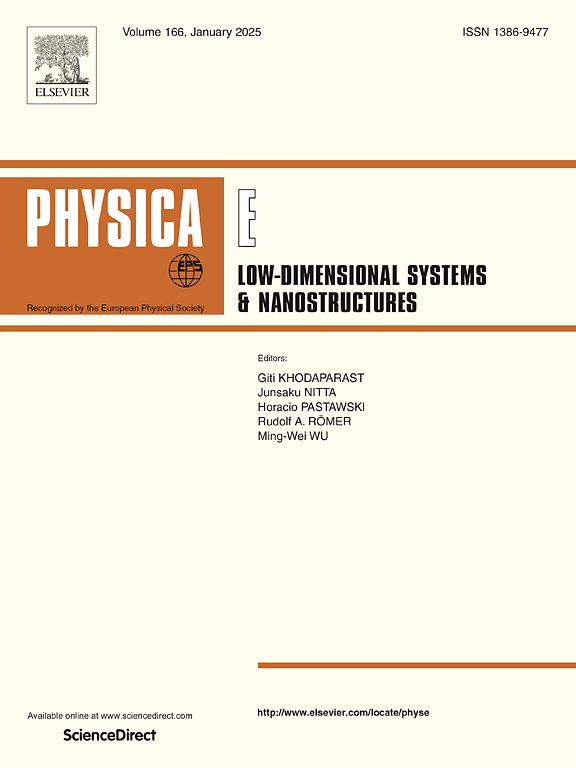通过磁场和激光在缺口石墨烯量子点中捕获电子
IF 2.9
3区 物理与天体物理
Q3 NANOSCIENCE & NANOTECHNOLOGY
Physica E-low-dimensional Systems & Nanostructures
Pub Date : 2025-04-28
DOI:10.1016/j.physe.2025.116273
引用次数: 0
摘要
本文研究了磁场、能隙和圆偏振激光照射下石墨烯量子点(GQDs)中的电子散射。利用Floquet方法和Dirac方程,导出了能量谱的解。通过匹配GQD界面上的本征旋量来显式计算散射系数,揭示了对几个物理参数的依赖。此外,我们计算了散射效率、电子密度分布和准束缚态的寿命。我们的数值结果表明,能量间隙和圆偏振激光照射的存在增强了GQDs内电子密度的局域化,导致准束缚态寿命的增加。特别是,光的强度和偏振影响散射过程,允许操纵电子约束状态。这些结果强调了结合磁场和偏振光来控制石墨烯纳米结构中的电子输运的重要性。本文章由计算机程序翻译,如有差异,请以英文原文为准。
Electron trapping via magnetic and laser fields in gapped graphene quantum dots
We study electron scattering in graphene quantum dots (GQDs) under the combined influence of a magnetic field, an energy gap, and circularly polarized laser irradiation. Using the Floquet approach and the Dirac equation, we derive the energy spectrum solutions. The scattering coefficients are calculated explicitly by matching the eigenspinors at the GQD interfaces, revealing a dependence on several physical parameters. In addition, we compute the scattering efficiency, the electron density distribution, and the lifetime of the quasi-bound states. Our numerical results show that the presence of an energy gap and circularly polarized laser irradiation enhances the localization of the electron density within the GQDs, leading to an increase in the lifetime of the quasi-bound states. In particular, the intensity and polarization of the light influence the scattering process, allowing the manipulation of the electron confinement state. These results highlight the importance of combining magnetic fields and polarized light to control electronic transport in graphene nanostructures.
求助全文
通过发布文献求助,成功后即可免费获取论文全文。
去求助
来源期刊
CiteScore
7.30
自引率
6.10%
发文量
356
审稿时长
65 days
期刊介绍:
Physica E: Low-dimensional systems and nanostructures contains papers and invited review articles on the fundamental and applied aspects of physics in low-dimensional electron systems, in semiconductor heterostructures, oxide interfaces, quantum wells and superlattices, quantum wires and dots, novel quantum states of matter such as topological insulators, and Weyl semimetals.
Both theoretical and experimental contributions are invited. Topics suitable for publication in this journal include spin related phenomena, optical and transport properties, many-body effects, integer and fractional quantum Hall effects, quantum spin Hall effect, single electron effects and devices, Majorana fermions, and other novel phenomena.
Keywords:
• topological insulators/superconductors, majorana fermions, Wyel semimetals;
• quantum and neuromorphic computing/quantum information physics and devices based on low dimensional systems;
• layered superconductivity, low dimensional systems with superconducting proximity effect;
• 2D materials such as transition metal dichalcogenides;
• oxide heterostructures including ZnO, SrTiO3 etc;
• carbon nanostructures (graphene, carbon nanotubes, diamond NV center, etc.)
• quantum wells and superlattices;
• quantum Hall effect, quantum spin Hall effect, quantum anomalous Hall effect;
• optical- and phonons-related phenomena;
• magnetic-semiconductor structures;
• charge/spin-, magnon-, skyrmion-, Cooper pair- and majorana fermion- transport and tunneling;
• ultra-fast nonlinear optical phenomena;
• novel devices and applications (such as high performance sensor, solar cell, etc);
• novel growth and fabrication techniques for nanostructures

 求助内容:
求助内容: 应助结果提醒方式:
应助结果提醒方式:


